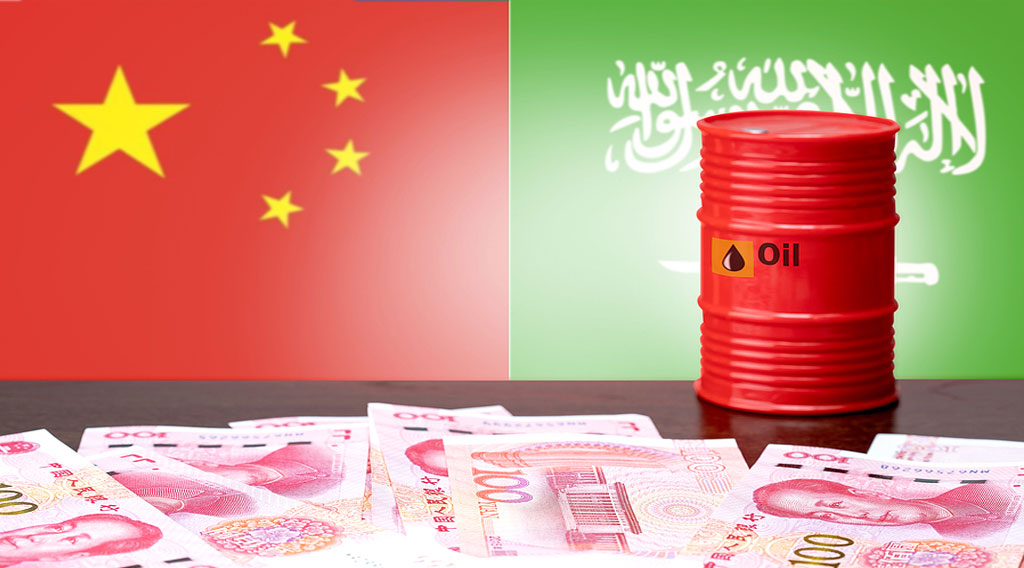 In the complex tapestry of global economics, few threads have been woven as deeply and firmly as the petrodollar system. As time passes, though, the knots keeping that system tethered are coming loose. After decades of promoting the petroyuan, China might have finally broken through the global economic patchwork to challenge the dollar’s hegemony.
In the complex tapestry of global economics, few threads have been woven as deeply and firmly as the petrodollar system. As time passes, though, the knots keeping that system tethered are coming loose. After decades of promoting the petroyuan, China might have finally broken through the global economic patchwork to challenge the dollar’s hegemony.
What is the Petroyuan?
The petroyuan is a specific version of Chinese currency specifically created for settling cross-border petroleum transactions. The term is a combination of the words petrol and yuan – the base unit of the CCP’s renminbi currency. Instead of being a physical form of money, the petroyuan is simply any Chinese currency used for the purchase of oil. China designed the petroyuan around the predominant petrodollar system which the currency is intended to rival.
The Rise of the Petroyuan
Understanding the development of the petroyuan requires a look into the history of how the global fiat-currency system came to be backed by oil, why the dollar became the de-facto reserve currency, and how China is challenging the petrodollar system.
The Creation of the Petrodollar
The monetary system of the US was based on the gold standard until 1973 when President Nixon ended the dollar’s convertibility to gold. To maintain the dollar’s stability and dominance on the world stage, Nixon struck a deal with Saudi Arabia to sell oil exclusively in USD in exchange for economic and military support. The rest of the Organization of Petroleum Exporting Countries (OPEC) nations followed suit in 1975, creating the petrodollar system. At the same time, China’s economy was in its infancy with a GDP nearly 1,000% smaller than the US. The petroyuan wasn’t on anyone’s radar at the time.
Chinese Economic Liberalization
Through the mid-20th century, China’s centrally planned economy was stymied by Draconian restrictions and deeply entrenched webs of bureaucracy. When these shackles were removed in the 1970s during a period of economic liberalization, China experienced astronomical year-over-year growth. This decades-long boom transformed The People’s Republic from a largely agrarian country to one of the world’s most powerful nations. When the 21st century rolled around, China had the financial resources, geopolitical influence, and global economic environment required to make the pitch for the petroyuan.

The Petrodollar: A Retrospective
How To Prepare For The Impending Dollar Failure
Get Report – It’s Free!World’s Largest Oil Importer
With an economy growing at breakneck speed and monumental population growth, China’s oil demands skyrocketed in the early 2000s. The US officially lost the title of the world’s largest importer of oil in 2017. This reliable and unwavering consumption of oil strengthened China’s economic and geopolitical relationship with Saudi Arabia and other OPEC nations. Experts anticipate China to set a new record for oil demand in 2023, furthering the CCP’s leverage in petroyuan negotiations with oil-exporting nations. As the official arbiters of how oil is priced, these nations wield tremendous influence on the foundation of the global monetary system. They can decide, at the snap of a finger, when and which currency would replace the dollar.
OPEC Nations Accept Petroyuan
In 2022, the Saudis openly discussed the possibility of accepting yuan for the first time. The consideration of the petroyuan alone was enough to send shockwaves through the dollar-dominated market. Less than two weeks after the announcement, the United Arab Emirates went a step further by settling liquid natural gas sales to China in petroyuan. These seemingly minor affronts to the petrodollar standard are symptoms of an underlying issue: Countries no longer see the US dollar as a worthwhile standard upon which to base their economies. Simultaneously, the yuan is looking increasingly promising as a USD substitute.
Yuan Dominates Chinese Trade
In 2023, the yuan superseded the dollar as the dominant currency for international trade involving China. This is a monumental shift as the USD dominates most cross-border transactions even between foreign countries. Every yuan Beijing uses when dealing with another nation is taking the place of a dollar. The result is an increased demand for Chinese currency abroad and greater momentum behind the international shift away from the greenback. If the yuan were to effectively replace the dollar as the reserve currency, the petroyuan would be a shoo-in.
Is China buying oil in yuan?
China is buying considerable amounts of oil from Russia in yuan. The stranglehold of international sanctions placed on Beijing and the Kremlin has had the unintended consequence of driving these US adversaries closer together. In fact, Russia recently supplanted Saudi Arabia as China’s largest oil supplier. The vast majority of crude oil and energy flowing into China from Russia is purchased with petroyuan. This economic cooperation outside the influence of the greenback further demonstrates its weakness and lack of appeal on the world stage. Furthermore, it reinforces the idea that countries can succeed without reliance on the dollar.
Will the petroyuan replace the petrodollar?
The petrodollar might have been the original oil-backed currency, but nothing is guaranteed in the wild west of world economics. Over the past few years, countries around the world have been eagerly decoupling their economies from American influence. We’re not only talking about China, Russia, and other US enemies either. Even long-time American allies such as Saudi Arabia and India are seeking alternatives to the dollar.
This process of de-dollarization is the result of a complicated mix of economic failures at home and failed international relations. Something about a $32 trillion dollar debt, systemic banking failures, and the record-setting export of inflation doesn’t instill confidence.
“The US government…has opened the door for China, and they’ve walked right through.”–Precious Metals Advisor John Karow
The dollar’s room for error is shrinking rapidly as the rise of competitive currencies offers viable alternatives. Right now, investors have their eyes on the petroyuan. There’s no telling if or when the petrodollar will be dethroned, but the greenback’s weaknesses are being exploited by the strength of the yuan. That imbalance only makes the potential of a petroyuan system more appealing to the rest of the world.
👉 Suggested Reading: De-Dollarization: A Timeline of Events
Stay Updated to Protect Your Wealth
The dominance of the petrodollar system has been a massive boon to American investors for decades. As a result, staying up to date on the growing influence of the petroyuan is essential for safeguarding your wealth. To learn more about the petroyuan and the potential risks to your future wealth, request our Free Guide to The Petrodollar.

